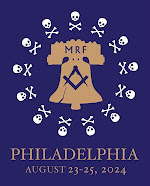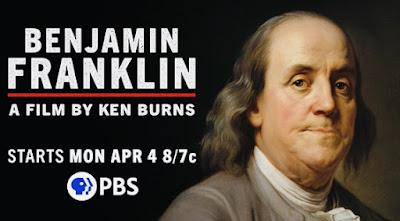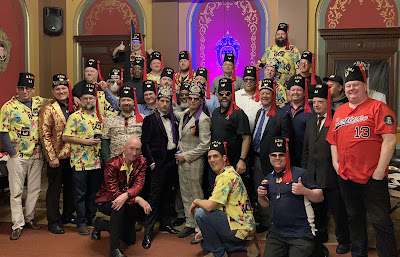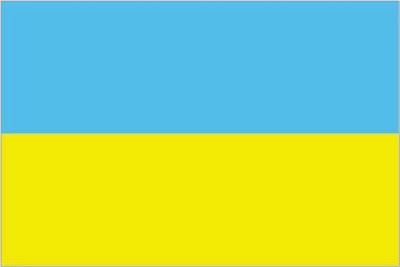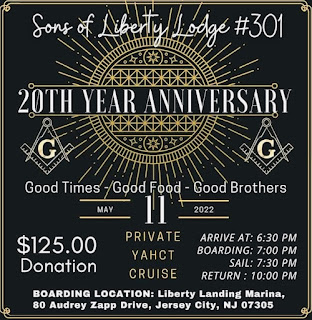Benjamin Franklin, revered Freemason, Founding Father, inventor, natural philosopher, statesman, entrepreneur, and more, is the subject of a two-part biography by filmmaker Ken Burns. It can be seen starting next Monday on PBS television and streaming.
Monday, March 28, 2022
‘Ben Franklin gets the Burns treatment’
Benjamin Franklin, revered Freemason, Founding Father, inventor, natural philosopher, statesman, entrepreneur, and more, is the subject of a two-part biography by filmmaker Ken Burns. It can be seen starting next Monday on PBS television and streaming.
Sunday, March 27, 2022
‘Bob Cooper on early catechisms’
 |
| Robert L.D. Cooper |
Saturday, March 26, 2022
‘Gentlemen of the White Apron’
My close personal friend Michael Halleran, former executive editor of The Journal of the Masonic Society, will make a long awaited return to New Jersey this summer to present a talk on Freemasonry in the U.S. Civil War. This will be hosted under the auspices of the education committee of the grand lodge there on Saturday, July 30 in the “Fellowship Center.”
Sunday, March 20, 2022
‘The ALR next week’
The American Lodge of Research will meet again next Tuesday at Masonic Hall. That’s March 29 at 7 p.m. in the Colonial Room on the tenth floor.
‘Washington inauguration re-enactment’
George Washington will be inaugurated again—and, really, what would you give to have him back in the presidency right now?—next month in the post-COVID return of the annual ceremony re-enactment. This will take place in Masonic Hall on Saturday, April 30, which is the anniversary of the 1789 inauguration of the first president.
Saturday, March 19, 2022
‘National Grotto Day 2022’
Another National Grotto Day is done, and Azim in New York City is ten Prophets richer, having put that many through the ceremonial at Masonic Hall this afternoon.
Note to self: Buy a costume befitting a religious leader. (I’m Chaplain for the ritual, and today I was surprised to become Chaplain for Azim’s meeting as well, so I better step up my wardrobe game.)
Tuesday, March 1, 2022
‘Sankey Lecture next month’
Sunday, February 27, 2022
‘Relief for Ukraine’
Grand Lodge is ready now to accept funds to help, aid, and assist the people of Ukraine. The statement from Masonic Hall this afternoon calls on the brethren to mail donations, “both large and small,” to:
‘Review: The Contemplative Lodge’
The Contemplative Lodge: A Manual for Masons Doing Inner Work Together by C.R. Dunning, Jr.
Stone Guild Publishing, 2021, 312 pages, paperback, $14.95
This reviewer must begin with a disclaimer: He purported to speak to Masonic audiences in recent years on mindfulness techniques for lodge life, but he would have been far better equipped had he been able to digest the contents of this brand new book.
The Contemplative Lodge by C.R. “Chuck” Dunning is a companion to his Contemplative Masonry from 2016.Where the latter guides a Freemason on how to adapt Masonic ritual and symbol for personal meditative purposes, the new book serves as a lodge of instruction,uniting groups of brethren in prayer, meditation, breathing exercises and other mindfulness habits conducive to Masonic labors. Dunning has been writing on these subjects for decades. In his professional career in higher education and mental health, as well as in Freemasonry, he teaches meditation techniques to groups and individuals. He was raised to the Sublime Degree in 1988, and he is very well known around the United States as a Masonic educator and author.
The Contemplative Lodge is understood in two denominations: First, its three chapters, spanning about 100 pages, beautifully explain how and why Masonic lodges can add a previously unknown reward to their work by embracing meditative techniques. It’s not that the author reinvents Masonry as meditation class as much as he directs our attention to what already is in the language and symbols we know so well. The ensuing two-thirds of the book offer four appendices that provide the actual instruction on meditation, chanting, energy work, and more.
The opening chapter forcefully argues the belief that Masons are taught repeatedly to work together. Dunning quotes from the three degrees and from authors of classic and contemporary books not to point out the obvious, but to find context for his vision of the lodge as a contemplative group. He cautions us against overzealousness in advocating for contemplative practices; admonishes us to not see these practices as hallmarks of an elite Freemasonry; and reminds us that every Mason is to be respected and loved even if these meditative techniques do not interest him. In short, he says, proper applications of the Compasses, Level, and Trowel.
One of the highlights of the second chapter is in Dunning’sexplanation of Masonic ritual work as a group contemplative act. “The entire process of preparing for and opening a meeting or ceremony is a series of exercises in establishing a proper atmosphere and attitude for each participant to become more fully aware of the ritual’s multilayered symbolism in words, images, and actions,” he writes. “In turn, the specific form of a given meeting or ceremony makes use of numerous methods to draw attention to particular focal points, stimulating the psyche to dwell on their potential meanings in one’s life.” While a certain kind of Mason would say “Yes, of course,” it is true that most Masons would find that statement revelatory.
Chapter Three is for the Master of the lodge. Dunning acknowledges the need for common sense management of our fraternity’s worldly business, but his trestle board really teaches how a Worshipful Master’s duties are mentoring as an initiator, mentoring as a teacher, and mentoring as a companion. Familiar concepts, yes, but he presents them in an alternative understanding.
Those four appendices contain the marrow, giving step-by-step instruction for the willing lodge. If the reader accepts Dunning’s proposition that the Masonic lodge’s speculative teachings and ritualized activities are meant for more than memorization and even study for comprehension, then it becomes plain to see how speculation and reflection produce a “focused, peaceful, and harmonious state of mind” in the present moment.
One section presents Eight Steps of Guided Meditation, useful whether addressing one individual or a group. There also are various scripts one may follow to facilitate group meditations. These center on very familiar Masonic symbols and other elements, such as the Gavel, the Blazing Star, the Mystic Tie (naturally), and Jacob’s Ladder.
Pages are devoted to Silent Sitting, which is not as simple as you might think. Conversely, the Chanting Meditations set certain melodic words to labor as intonations that can only cure any emotional or psychological mood that otherwise may spoil a brother’s time in lodge. (Your reviewer can vouch for this thanks to work in an esoteric order where this sort of chanting induces a gentle euphoria. He is smiling involuntarily now merely from thinking about it.)
I would prefer to quote extensively from The Contemplative Lodge, but I’ll just delve into Energizing the Plumb Line on Page 251: First, extensive breathing exercises defeat any tension there might be throughout the body until a rhythmic respiration calms the mind. Then, the participants are instructed to “imagine a plumb line, a small straight line of brilliant white light running into the top of your head from the highest heavens, and down through your body into the depths of the Earth…like a magnetic or electrical current flowing…. Feel the pure white light as warm, cleansing, healing, and energizing.” After further instruction, participants are to “stop circulating the energy and breathe naturally, continuing to imagine the brilliant white plumb line running through your body between the highest heavens and the center of the Earth. Attend to any effects this work has on your body, emotions, and thoughts.” You may never see the jewel of the Junior Warden, who governs the time of refreshment, quite the same way again.
For the Freemason who views his Craft as a mystery school, The Contemplative Lodge delivers essential vindicating reading, while the brother for whom Masonry is a fraternity can enhance his profit and pleasure through Dunning’s instructive emphasis on how brethren can achieve inner work together. All the brethren can dwell together in unity.
Friday, February 25, 2022
‘Lodge with No Name 10,000’
 |
| S. Khan photo |
The United Grand Lodge of England consecrated its 10,000th lodge Tuesday. It is a grand lodge that does not recycle lodge numbers, so this is a true sequential 10,000 since 1813.
 |
| Five of Nine Club photo |
MW Bro. Peter Geoffrey Lowndes, Pro Grand Master, led the ceremony, which took place inside beautiful Lodge Room 10 in Freemasons’ Hall, London.
 |
| chelt_mason |
Thursday, February 24, 2022
‘Ukraine’
The website of the Grand Lodge of Ukraine is down, as probably all civilian communications in the country are defeated by Russian cyber warfare now that the military invasion is underway.
 |
| Grand Lodge of Ukraine photo |
In 2005, the National Grand Lodge of France (that’s the French one we recognize) and the Grand Lodge of Austria consecrated the current Grand Lodge of Ukraine.
 |
| Past Grand Master Bill Sardone with Ukraine Grand Master Anatoly Dymchuk last November in Berlin during the International Conference of Regular Masonic Grand Lodges. |
I hear there supposedly has been a Ukrainian Masonic Club in New York.
Wednesday, February 23, 2022
‘It was twenty years ago today’
 |
| Random House USA |
On this date in 2002, New Jersey Lodge of Masonic Research and Education 1786 was constituted by Grand Master David A. Chase. This singular occurrence more than likely is what resulted in me remaining in the fraternity beyond a couple more years.
Tuesday, February 22, 2022
‘Washington Masonic bio is out’
On the day George Washington was born, the date was February 11, but today is Washington’s birthday because of the change in 1752 from the Julian calendar to the Gregorian calendar. That’s a long story involving Astronomy, Arithmetic, Logic, and a pope, but what better occasion than this to buy Mark Tabbert’s new book?
Sunday, February 20, 2022
‘The very cement and support of society’
It’s not often a lodge thinks to tender a formal statement of contemporary social importance. Of course that’s not easy to do. Government intrudes into our lives so often and so directly, it’s nearly impossible to form a civic-minded opinion that doesn’t trespass into partisan politics. Like sectarian religious views, political opinions are forbidden in our lodges. That is a key ingredient that makes our essential harmony possible, but it also has stifled much potential discussion of ideas. We seem to have filled the silence with less provocative conversations, and the fraternity expects its lodges and their members to act, and make Masonic charity evident in their activities.
Saturday, February 19, 2022
‘Masonic Week 2022’
I meant to post this a week ago, but it’s been busy and, frankly, social media renders Magpie coverage of Masonic Week redundant. I mean, during last Saturday’s AMD Grand Council Annual Communication, Barry was tweeting and I was Faceypaging progress of the meeting in real time. And then came tons of everyone’s photos. So this edition of The Magpie Mason is brief—I attended only several events anyway—and it is light on photography. There were No Photography signs posted around the meeting room but, unknown to me, they referred to the degree conferrals and not to the business meetings. So I inadvertently denied you my customary lens work, capturing the scenes of the same ten guys appointing each other to the officer lines.
Having been awake for twenty-two hours by the time we entered the banquet room, an endodontic job, sans anesthesia, would have been fine by me, but this was a true pleasure and a high note on which to conclude my term as president.
Chris told us of the persons, places, and things involved in how the District took shape with Masons participating, from the placement of the Boundary Stones that marked the city’s borders in 1791, to the construction of the Executive Mansion in 1792, to the cornerstone ceremony at the Capitol in 1793, with a lot more around town and into the next century too, including recovery from the arson of the War of 1812, and up to the Lincoln years. (I resisted the temptation to say that very day, February 11, was the anniversary of the start of the surveying process in 1791 that established the District’s boundaries.)
 |
| Adam, Balvin, and David. |
I encourage you to seek the several videos on YouTube of Adam’s previous tellings of the tale.



























